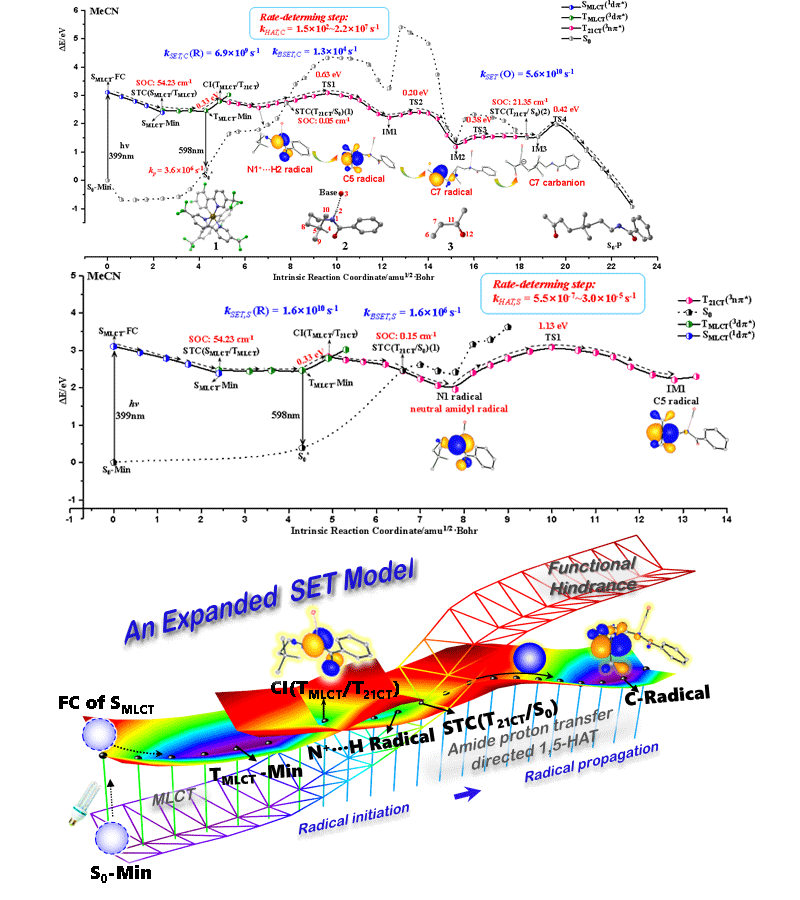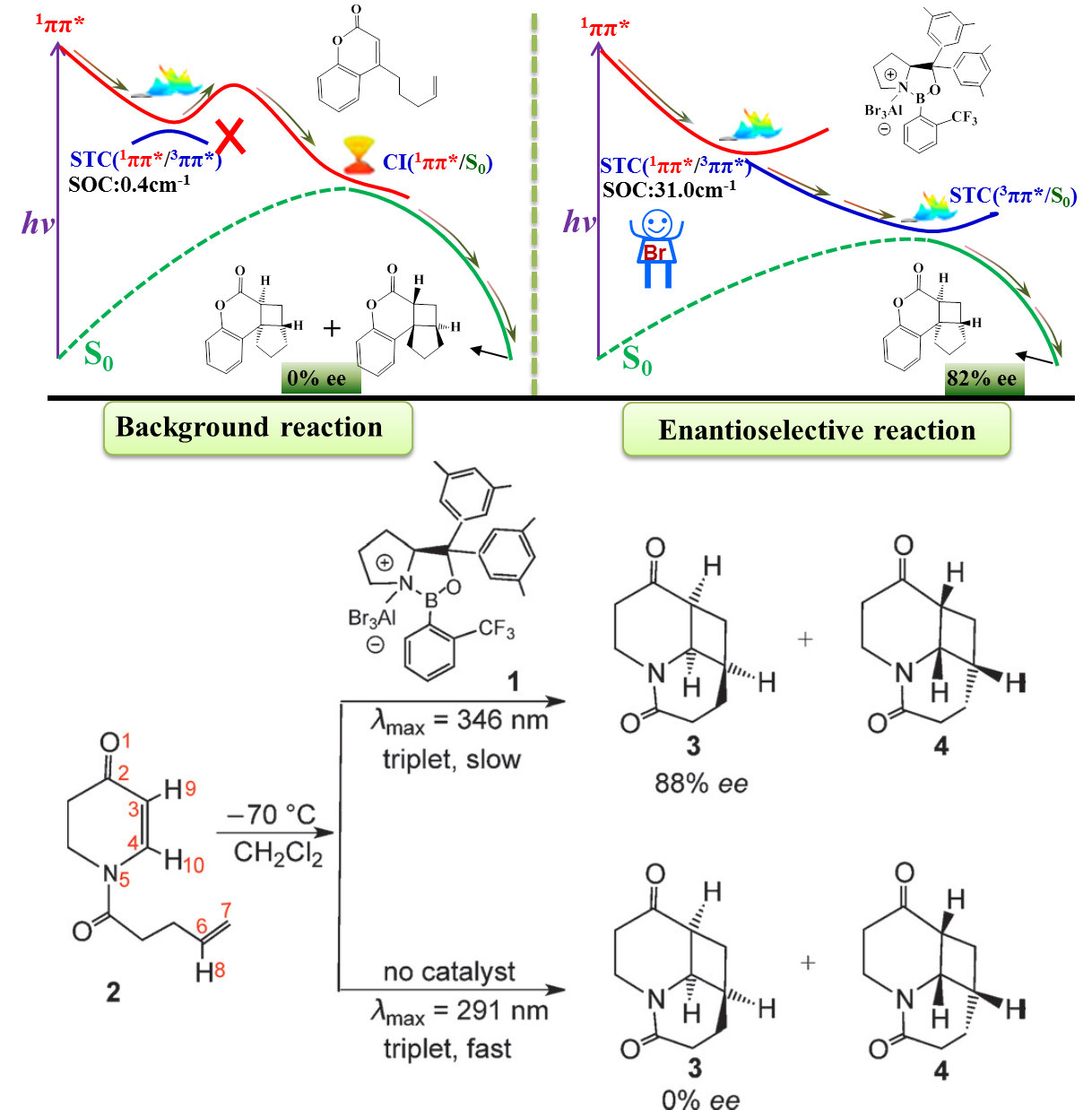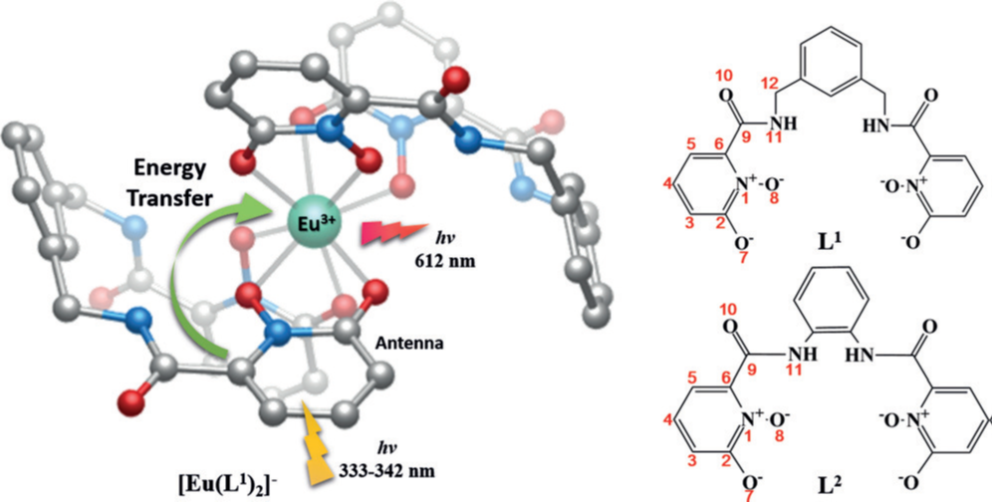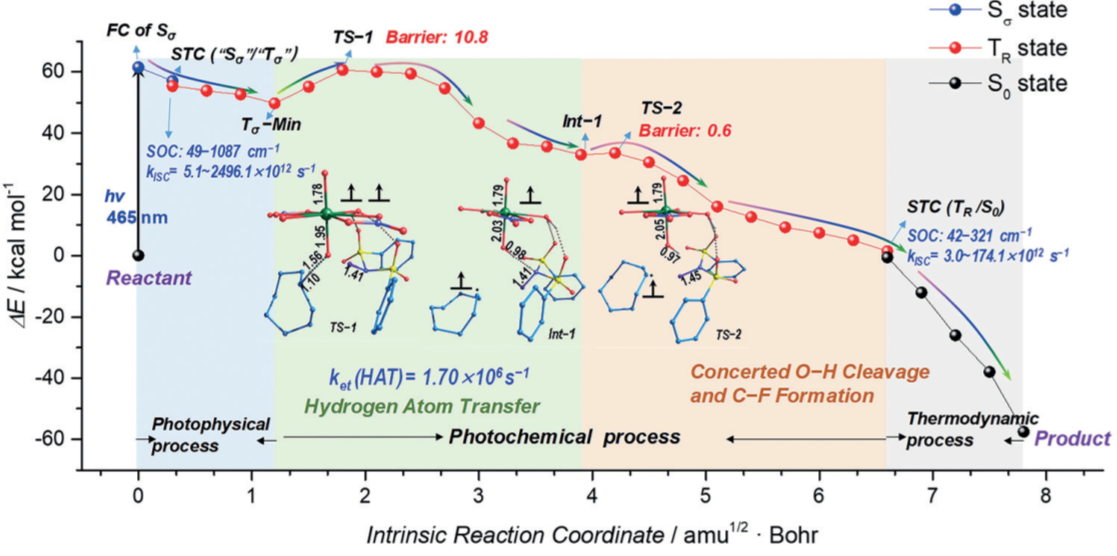光氧化还原催化酰胺导向的远端sp3 C-H烷基化反应机理研究 及激发态电子转移模型拓展

传统Marcus电子转移和过渡态理论不能准确描述诸如酰胺导向远端sp3 C-H烷基化反应等特殊光氧化还原催化反应的电子和能量控制因素,因此无法借助精确的动力学评估实现光催化反应的优化,更不能从根本解决光催化反应量子产率偏低的问题。
我们运用基于CASPT2//CASSCF多组态微扰理论并结合轨道局域化和组态优选方案,计算得到Ir(III) 复合物催化的酰胺远端sp3 C-H键烷基化反应分步和协同过程的激发态最低能量反应途径,及其控制激发态还原、氧化和反向电子转移及氢迁移反应的关键物理参数。基于上述激发态电子结构和动力学参数,首次发现了由非绝热交叉和1,5-氢原子迁移(HAT)过渡态相结合的新型电子转移理论模型。进一步的动力学计算发现,由于远端sp3 C-H活化高能需求使得催化反应的决速步骤不再是还原电子转移而是后续的1,5-氢原子迁移反应,并因其自由基反应特性使催化反应表现出反常溶剂化效应。动力学数据进一步揭示了光催化反应量子产率损失主要归因于分步反应过程中低效的氢迁移和高效的反向电子转移。在分步过程中,光诱导产生的催化剂-底物阴阳离子对沿着分步势能面以高效的反向电子转移恢复到闭壳层基态。而协同机制使得催化反应能够高效进行,主要得益于生成稳定的碳自由基中间体、结合反向SET的功能挡板以及三重反应态和闭壳层基态的能量反转,很大程度上关闭了自由基抑制通道。最后,我们的计算结果为光催化剂的分子设计和催化反应优化提供可行方案,主要包括利用吸电子基调控光催化剂的氧化还原电势和催化动力学过程,并综合地考虑溶剂效应与底物的吸电子效应。
ref:
[1] Generation and direct observation of a triplet arylnitrenium ion; Lili Du, Juanjuan Wang, Yunfan Qiu, Runhui Liang, Penglin Lu, Xuebo Chen*, David Lee Phillips*, Arthur H Winter*; Nat. Commun. 2022, 13(1), 1-9.
三重态氮宾离子的惊鸿一瞥

氮宾离子是一种反应活性极高、缺电子的含氮化合物,通式为RR′N+。其中,氮带一个正电荷。长期以来,由芳香胺和酰胺转化产生的氮宾离子,被认为是具有诱变特性以及导致DNA损伤的强致癌物。例如,芳环胺和杂芳环胺通过环外氨基的氮-羟基化代谢激活反应产生的芳基氮宾离子,是产生毒性和导致DNA损伤的关键代谢产物。氮宾离子的电子组态主要有闭壳层单重态n2,开壳层单重态np,第二闭壳层单重态p2和开壳层三重态np。实验观察到的大多数芳香基氮宾离子都为 n2 单重态,主要源于苯环π 轨道上的电荷离域至N中心的p 轨道稳定了该电子组态。目前为止,除了NH2+,鲜有研究报道预测其它三重态氮离子的存在。因此,捕捉和指认高活性和高能量的三重态氮宾离子对实验和理论研究来说都是极具挑战性的工作。
我们与时间分辨光谱实验课题组紧密合作,运用基于多组态微扰理论的高精度激发态电子结构计算方法,对2-(4-碘-苯基)肼-1-四氟硼酸盐光解生成氮宾离子的动力学过程进行了系统研究。计算发现,在紫外光照射下,反应前驱体首先生成了从苯环到N-N 键的长程电荷迁移激发态(1*),这种光诱导的电荷重排导致了N-N键的初步活化。由于重原子碘的参与,使体系在皮秒级的时间尺度内完成从1*态到3n*的系间窜越。时间分辨光谱实验在10-50 ps检测到了三重态信号,验证了理论计算结果的合理性。随后,体系沿着3n*态反应路径弛豫,N-N键快速断裂并伴随从苯环到-NH3+的电荷迁移,最终生成电子组态为TNPz(np)的双自由基氮宾离子以及中性的NH3。该三重态氮宾离子能够在纳秒级别再次发生系间窜越,两个单电子在平行于苯环平面的N的n轨道上配对,生成闭壳层氮宾离子12(n2)。另一方面,前驱体可以在单重激发态(1nσ*)发生异裂过程,形成与ISC过程竞争的反应通道,直接产生单重态氮宾离子12(n2)。这与时间分辨光谱实验在纳秒时间尺度内观测到的闭壳层基态信号相吻合。进一步的实验发现,三重态氮宾离子也可以通过质子和电子转移过程形成自由基阳离子物种,最终产生以对碘苯胺为主要的光产物。而单线态氮宾离子则通过双阳离子物质生成对苯二胺,说明氮宾离子的反应活性受其电子组态的影响。
ref:
[1]An Expanded SET Model Associated with the Functional Hindrance Dominates the Amide-Directed Distal sp3 C-H Functionalization; Juanjuan Wang, Weihai Fang, Lingbo Qu, Lin Shen*, Feliu Maseras *, Xuebo Chen *; Journal of the American Chemical Society, 2021, 143(46): 19406-19416.
经含有重原子的路易斯酸催化剂调节的对映选择性的分子内烯酮的[2+2]光环加成反应

[2+2]光环加成反应一直是人们研究的热点问题,因为它能够广泛地应用到天然产物和非天然产物的有机合成。随着対映选择性的出现,手性已经成为物质的重要特性,进而如何获得高e.e值的[2+2]光环加成产物引起了化学家们的极大兴趣。2013年,德国的Bach教授首次将噁唑硼烷手性路易斯酸催化剂应用到烯酮的分子内[2+2]光环加成反应中,在降低反应条件的同时,成功分离得到高产率、高选择性的対映异构体。在过去的几年里,虽然在实验水平上对路易斯酸催化的[2+2]光环加成反应已经进行了大量研究,但是关于催化剂对反应的调控机理仍然没有给出合理的解释。
我们采用高精度的计算方法(CASPT2//CASSCF)首次揭示了路易斯酸催化剂对対映选择性的[2+2]光环加成反应的调控机理。计算表明,在没有催化剂的条件下,底物分子在光激发后可以经nπ*调节发生快速的系间窜越达到3ππ*,进而非选择性的[2+2]反应主要发生在3ππ*。催化剂的加入不仅可以增大激发态分子的电荷转移程度,使得吸收、发射波长红移,反应条件降低;同时可促进nπ*/ππ* 态之间的能量反转,使得nπ*作用失效。通过对不同的路易斯酸催化剂进行对比,揭示了催化剂配位条件下的[2+2]光环加成是由重原子的相对论效应引起的增强的旋轨耦合直接调控的。而手性催化剂的空间位阻效应有效地促进対映选择性反应的发生。此次研究不仅成功地解释了路易斯酸催化剂在光化学反应中的重要作用,也为有机光催化合成夯实了理论基础。
ref:
[1] Wang H, Cao X, Chen X, et al. Regulatory Mechanism of the Enantioselective Intramolecular Enone [2+2] Photocycloaddition Reaction Mediated by a Chiral Lewis Acid Catalyst Containing Heavy Atoms.[J]. Angewandte Chemie, 2016, 127(48):14503-14506.
[2] Wang H, Fang W H, Chen X. Mechanism of the Enantioselective Intramolecular [2 + 2] Photocycloaddition Reaction of Coumarin Catalyzed by a Chiral Lewis Acid: Comparison with Enone Substrates.[J]. Journal of Organic Chemistry, 2016, 81(16):7093.
镧系金属离子-天线探针配合物发光机制的理论研究

我们提出了由九重态–五重态势能面交叉控制的能量转移模型,合理揭示了Eu–天线配合物探针的发光机制。该能量转移模型依赖于激发九重态和五重态之间的能量共振以及相应的旋轨耦合作用。对比单独配体和Eu–天线配合物的激发态弛豫过程发现,通过将天线基团与Eu3+配位,形成的Eu–O配位作用可以极大地改变单独配体的势能面拓扑结构,使原本不相交的单三态势能面变得近简并。一旦配合物到达配体为中心的三重态,便可以通过3ππ* → S0系间窜越退激发过程供出能量,驱使Eu3+中心离子4f电子配对实现间接激发至五重态。在能量转移的过程中,配体通过系间窜越回到基态供出能量的过程为决速步骤。我们提出的共振能量转移模型是对经典Förster和Dexter 能量转移机理的有益补充,为理解镧系配合物的敏化发光,提供了新的视角,并将驱动镧系发光材料新的研究和设计。
ref:
p>Zhang Q, Wu L, Cao X, Chen X, et al. Energy Resonance Crossing Controls the Photoluminescence of Europium Antenna Probes[J]. Angew Chem Int Ed Engl, 2017, 56(27).可见光催化剂铀酰催化C(sp3)–H键氟化的理论研究

运用多组态微扰的CASPT2//CASSCF方法并结合标量相对论赝势,系统研究了铀酰光催化环辛烷氟化反应中激发态单电子转移(SET)的触发、弛豫和失活过程。计算发现:i)通过光诱导的单电子转移,在底物和催化剂之间发生有利于反应进行的电荷重新分布,从而有效降低反应能垒,使惰性共价键的活化成为可能;ii)正是由于金属U强相对论效应能显著提高光催化剂的自旋–轨道相互作用,从而加速光催化剂Sσ→Tσ和Tσ→S0*的系间窜越速率,提高催化效率;iii)光激发的催化剂能与非选择的酮类、芳香类底物形成激基复合物,并通过能量可及的单三态交叉点弛豫到基态,关闭催化通道。从而解释了在烷基苯和环酮存在的条件下,铀酰催化剂依然能高选择性地催化活化环辛烷惰性C(sp3)–H键。
ref:
Wu L, Cao X, Chen X, et al. Visible‐Light Photocatalysis of C(sp3)‐H Fluorination by the Uranyl Ion: Mechanistic Insights[J]. Angewandte Chemie International Edition.
柔性链对分子运动的抑制功能的研究

人工分子机器研究受天然蛋白质分子机器的启发而诞生,其试图构筑的于分子尺度下运行的人工机器在智能材料、新传感器、智能药物运输和能量储存等方面有着巨大的应用潜力。柔性链作为一种具有显著区别于刚性结构性质的分子基团,其特殊的柔顺性和链段间运动的协同性在天然蛋白质分子机器的运作中发挥重要作用,如调节蛋白质对底物的络合、以及提高蛋白质转运的运动速率等。然而,在当前相关的人工分子机器研究中,柔性链普遍地仅仅表现出柔顺性,几乎没有任何抑制或改变分子体系运动的能力。这极大的妨碍了科研人员对柔性链在天然蛋白质分子机器中的功能机制的理解,同时也限制了柔性链在人工分子机器中的应用。
我们以精确的电子结构计算为基础,设计了柔性链和分子转门构成的分子机器模型,并预示了分子机器中柔性链的结构和功能间的依赖关系,随后完全被实验证实;与实验紧密结合,协同研究了有机刚性大环的自组装过程,发现了新奇的分立堆积自组装方式。
ref:
Yu C, Ma L, He J, Chen X, et al. Flexible, Linear Chains Act as Baffles To Inhibit the Intramolecular Rotation of Molecular Turnstiles.[J]. Journal of the American Chemical Society, 2016, 138(49).
2024:
1. Unveiling Mechanistic Insights and Photocatalytic Advancements in Intramolecular Photo-(3+2)-Cycloaddition: A Comparative Assessment of Two Paradigmatic Single-Electron-Transfer Models. JACS Au. 2024, 4 (2), 419-431
2. Machine learning-assisted amidase-catalytic enantioselectivity prediction and rational design of variants for improving enantioselectivity. Nat Commun. 2024, 15, 8778
3. Lanthanide-Dependent Photochemical and Photophysical Properties of Lanthanide–Anthracene Complexes: Experimental and Theoretical Approaches. JACS Au. 2024, 4 (9), 3606-3618.
4. Discovery of Novel Iridium (III) Complex-Based Photofunctional Materials Using Excited-State Descriptors, Adv. Optical Mater. 2024, 2402317
5. Strain-Release-Driven Electrochemical Skeletal Rearrangement of Non-Biased Alkyl Cyclopropanes/Butanes. Angew. Chem. Int. Ed. 2024, e202413723
6. High-Throughput Screening Strategy for Electrocatalysts for Selective Catalytic Oxidation of Formaldehyde to Formic Acid. J. Phys. Chem. Lett. 2024, 15, 6183-6189.
7. Monitoring Hierarchical Assembly of Ring-in-Ring and Russian Doll Complexes Based on Carbon Nanoring by Forster Resonance Energy Transfer. JACS Au. 2024 4(2): 402-410.
8. Slruclurally Diverse Pyrene - decorated Planar Chiral [2,2]Paracyclophanes with TunableCirculary Polarized Luminescence between Monomer and Excimer. Chemistny-AEuropean Joumal,2024.30
9.Ignition and combustion mechanism of alcohol/aluminum suspension nano-fluid droplets. Fuel. 2024, 358, 130047
10.The Special Activity of Stone–Wales Defect Graphene for the Oxygen Reduction Reaction: A Comparison Study between the Charge-Neutral Model and the Constant Potential Model Calculated by Density Functional Theory. J. Phys. Chem. C 2024, 128, 8, 3250–3259
11.Chiral phosphoric acid (CPA)-catalyzed transformation reaction of ketene: Competing mechanisms and origin of regio- and stereoselectivities. Molecular Catalysis.2024, 560, 114150.
12.Unveiling mechanisms in Cu2O-catalyzed electroreduction of CO2 through theoretical resolution using periodic boundary and saturation cluster models. Applied Surface Science.2024, 657, 159828.
13.Exploring the impact of S-doped Fe-N-C materials on the ORR mechanism within a constant potential solvation model. Molecular Catalysis.2024, 559, 114119.
14.Design and screening of multifunctional NOx electroreduction catalysts for ammonia production. Materials Today Communications.2024, 38, 108038.
15.Design and screening of a NORR electrocatalyst with co-coordinating active centers of the support and coordination atoms: a machine learning descriptor for quantifying eigen properties. J. Mater. Chem. A,2024, 12, 8226–8235.
16.Probing Coordination Number of Single-Atom Catalysts by d-Band Center-Regulated Luminescence. Angew. Chem.Int. Ed.2024,63, e202401214
17.The nearby atomic environment effect on an Fe–N–C catalyst for the oxygen reduction reaction: a density functional theory-based study. Phys. Chem. Chem. Phys., 2024, 26, 6826–6833
18.Exploring Tunable Properties, Solvent-Modulated Dynamics, and Novel C(sp3)–H Activation Mechanisms in Electron Donor–Acceptor Complexes.J. Phys. Chem. Lett. 2024, 15, 12, 3412–3418
2023:
1.Co-function Mechanisms of Chlorine and Alkoxy Radicals in Cerium-Catalyzed C–H Functionalization of Alkane Mediated by Visible Light. J. Phys. Chem. Lett. 2023, 14, 26, 6187–6192
2.Extended Single-Electron Transfer Model and Dynamically Associated Energy Transfer Event in a Dual-Functional Catalyst System. JACS Au 2023, 3(5), 1452–1463
2022:
1.Generation and direct observation of a triplet arylnitrenium ion; Lili Du, Juanjuan Wang, Yunfan Qiu, Runhui Liang, Penglin Lu, Xuebo Chen*, David Lee Phillips*, Arthur H Winter*; Nat. Commun. 2022, 13(1), 1-9.
2.Theoretical Exploration on Energy Transfer and Single Electron Transfer Mechanisms for Understanding the Generation of Triplet Nitrene and the C(sp3)-H Amidation with Photocatalysts. Yanting Yang, Lin Liu, Wei-Hai Fang, Lin Shen*, Xuebo Chen*; JACS Au, 2022, https://doi.org/10.1021/jacsau.2c00490
3.Excited-state Dynamics of Crossing Controlled Energy Transfer in Europium Complexes; Liangliang Wu, Yu Fang, Wanlong Zuo, Juanjuan Wang, Ju Wang, Shufeng Wang, Zhifeng Cui, Weihai Fang, HaoLing Sun*, Yunliang Li*, Xuebo Chen*; JACS Au, 2022, 2 (4), 853-864.
4.In situ localization of BiVO4 onto two-dimensional MXene promoting photoelectrochemical nitrogen reduction to ammonia; Demei Zhang, Shiyu Yang, Xiaoyu Fang, Huifeng Li, Xuebo Chen*, Dongpeng Yan; Chinese Chemical Letters, 2022, 33(10), 4669-4674.
5.Prediction on chemoselectivity for selected organocatalytic reactions by the DFT version of the Huckel-defined free valence index; Limin Guo, Juanjuan Wang, Jing Luo, Qianqian Shi, Donghui Wei*, Xuebo Chen*; Catalysis Science & Technology, 2022, 12(21), 6486-6494.
6.Ultrathin Two-Dimensional Bimetal-Organic Framework Nanosheets as High-Performance Electrocatalysts for Benzyl Alcohol Oxidation Yujing Song, Mengwei Yuan, Wenli Su, Donghua Guo, Xuebo Chen*, Genban Sun*, Wenkai Zhang*; Inorganic Chemistry. 2022, 61(19), 7308-7317.
7.Corannulene-based acenes; Qi Xu, Chu Wang, Xuebo Chen, Ying Wang, Zhenyao Shen, Hua Jiang*; Organic Chemistry Frontiers. 2022, 9(18), 4981-4989.
8.Mechanistic Insights into Visible-Light-Driven Dearomative Fluoroalkylation Mediated by an Electron Donor–Acceptor Complex; Lishuang Ma*, Wenxu Feng, Yanyan Xi, Xuebo Chen*, Xufeng Lin*; The Journal of Organic Chemistry, 2022, 87(2): 944-951.
2021:
1.An Expanded SET Model Associated with the Functional Hindrance Dominates the Amide-Directed Distal sp3 C-H Functionalization; Juanjuan Wang, Weihai Fang, Lingbo Qu, Lin Shen*, Feliu Maseras *, Xuebo Chen *; Journal of the American Chemical Society, 2021, 143(46): 19406-19416.
2.A quadruple helicene with a rubicene core: synthesis, structural analyses and properties; Qi Xu, Chu Wang, Dan Zheng, Ying Wang, Xuebo Chen*, Di Sun*, Hua Jiang*; Science China-Chemistry. 2021, 64(4), 590-598.
3.Precise Identification of the Dimethyl Sulfoxide Triggered Tricarbonyldichlororuthenium(II) Dimer for Releasing CO; Jiangrui Zhu, Juanjuan Wang, Guosheng Wang, Jia Zhang, Wei Tao, Chang Liu, Ming Liu, Hao Zhang, Ruipei Xie, Fangfu Ye, Ying Liu, Weihai Fang*, Xuebo Chen*, Yunliang Li*; Journal of Physical Chemistry Letters. 2021, 12 (19), 4658-4665.
4.Corannulene-based nanographene containing helical motifs; Qi Xu, Chu Wang, Jing He, Xiaonan Li, Ying Wang, Xuebo Chen*, Di Sun*, Hua Jiang*; Organic Chemistry Frontiers. 2021, 8 (12), 2970-2976.
5.A Distorted Hybrid Corannulene-Dibenzobistetracene; Qi Xu, Chu Wang, Dan Zheng, Jing He, Ying Wang, Xuebo Chen*, Hua Jiang*; Journal of Organic Chemistry. 2021, 86 (20), 13990-13996.
6.Distance-Dependent Chiral Communication between Two Quinoline Oligoamide Foldamers Connected by Alkyl Chains; Lu Zheng, Shengzhu Guo, Chu Wang, Yanru Wang, Yanqing Fan, Xuebo Chen*, Kun Zhang*, Hua Jiang*; Chempluschem. 2021, 86 (2), 340-346.
2020:
1.Fe, Mo N/C Hollow Porous Nitrogen-Doped Carbon Nanorods as an Effective Electrocatalyst for N-2 Reduction Reaction; Wen Ye, Yongsheng Yang, Muhammad Arif, Shiyu Yang, Xiaoyu Fang, Muhammad Asim Mushtaq, Xuebo Chen*, Dongpeng Yan*; ACS Sustainable Chemistry &Engineering. 2020, 8(42), 15946-15952.
2.Tuning the Properties of Corannulene-Based Polycyclic Aromatic Hydrocarbons by Varying the Fusing Positions of Corannulene. Qi Xu, Chu Wang, Yu Zhao, Dan Zheng, Chengyuan Shao, Weijie Guo, Xuebin Deng, Ying Wang, Xuebo Chen*, Jun Zhu*, Di Sun*, Hua Jiang*; Organic Letters, 2020, 22 (18), 7397-7402.
3.Ester-derivatized indoles as sensitive infrared probes for local environment; Jingsong Liu, Xinyue Huang, Haoran Fan, Wenli Su, Xuebo Chen*, Wenkai Zhang*; Chemical Physics Letters. 2020, 742, 137139.
2019:
1.Regulatory mechanism and kinetic assessment of energy transfer catalysis mediated by visible light; Lishuang Ma, Wei-Hai Fang, Lin Shen*, Xuebo Chen*; ACS Catalysis, 2019, 9(4): 3672-3684.
2.Efficient Photoelectrochemical Route for the Ambient Reduction of N2 to NH3 Based on Nanojunctions Assembled from MoS2 Nanosheets and TiO2; Wen Ye, Muhammad Arif, Xiaoyu Fang, Muhammad Asim Mushtaq, Xuebo Chen*, Dongpeng Yan*; ACS Applied Materials & Interfaces, 2019, 11(32): 28809-28817.
3.2D cocrystallized metal–organic nanosheet array as an efficient and stable bifunctional electrocatalyst for overall water splitting; Wen Ye, Yongsheng Yang, Xiaoyu Fang, Muhammad Arif, Xuebo Chen*, Dongpeng Yan*; ACS Sustainable Chemistry & Engineering, 2019, 7(21): 18085-18092.
4.A tunable photo-release mechanism of phototrigger compound varying the pH value and excitation wavelength; Lishuang Ma, Qin Zhao, Xiaorui Zhang, Xuebo Chen*; Chemical Physics Letters. 2019, 730, 253-258.
2018:
1.Visible-Light Photocatalysis of C(sp(3))-H Fluorination by the Uranyl Ion: Mechanistic Insights; Liangliang Wu, Xiaoyan Cao, Xuebo Chen*, Weihai Fang*, Michael Dolg*; Angewandte Chemie International Edition, 2018, 57(36): 11812-11816.
2.Dynamics of oxygen independent photocleavage of blebbistatin light-gated hydroxyl radical; Ming-De Li*, Nai-Kei Wong, Jia Xiao, Ruixue Zhu, Liangliang Wu, Sheng-Yao Dai, Feng Chen, Guanheng Huang, Liang Xu, Xiaoyu Bai, Margarita R. Geraskina, Arthur H.Winter, Xuebo Chen*, Yingxia Liu, Weihai Fang, Dan Yang*, David Lee Phillips*, Journal of the American Chemical Society. 2018, 140, 15957-15968.
3.One-Pot Photomediated Giese Reaction/Friedel–Crafts Hydroxyalkylation/Oxidative Aromatization To Access Naphthalene Derivatives from Toluenes and Enones; Haiwang Liu, Lishuang Ma, Rong Zhou, Xuebo Chen*, Weihai Fang, Jie Wu*; ACS Catalysis, 2018, 8(7): 6224-6229.
4.Nonadiabatic curve-crossing model for the visible-light photoredox catalytic generation of radical intermediate via a concerted mechanism; Wenjing Yang, Xuebo Chen*, Weihai Fang*; ACS Catalysis, 2018, 8: 7388-7396.
5.Enhance the performance of polymer solar cells via extension of the flanking end groups of fused ring acceptors; Shiyu Feng, Danyang Ma, Liangliang Wu, Yahui Liu, Cai'e Zhang, Xinjun Xu*, Xuebo Chen, Shouke Yan*, Zhishan Bo*; Science China-Chemistry. 2018, 61 (10), 1320-1327.
6.A three-dimensional nickel–chromium layered double hydroxide micro/nanosheet array as an efficient and stable bifunctional electrocatalyst for overall water splitting; Wen Ye, Xiaoyu Fang, Xuebo Chen*, Dongpeng Yan*; Nanoscale, 2018, 10(41): 19484-19491.
7.Electron Transfer Controls the Photochemical Splitting of Water Mediated by a Titanocene Transition Metal Complex. Lu Jin, Juanjuan Wang, Wen Ye, Weihai Fang*, Xuebo Chen*; Journal of Materials Chemistry C. 2018, 122(32), 18412-18421.
8.A propeller-shaped perylene diimide hexamer as a nonfullerene acceptor for organic solar cells. Juncheng Liu, Sufei Xie, Shiyu Feng, Miao Li, Liangliang Wu, Xinjun Xu, Xuebo Chen*, Cuihong Li*, Zhishan Bo*; Journal of Materials Chemistry C. 2018, 6(35), 9336-9340.
9.Influence of substrate temperature on the film morphology and photovoltaic performance of non-fullerene organic solar cells. Jicheng Zhang, Sufei Xie, Zhen Lu, Yang Wu, Hongmei Xiao, Xuejuan Zhang, Guangwu Li, Cuihong Li*, Xuebo Chen*, Wei Ma*, Zhishan Bo*; Solar Energy Materials and Solar Cells. 2018, 174, 1-6.
10.Self-Assembled Carcerand-like Cage with a Thermoregulated Selective Binding Preference for Purification of High-Purity C-60 and C-70; Weidong Sun, Ying Wang, Lishuang Ma, Lu Zheng, Weihai Fang, Xuebo Chen*, Hua Jiang*; Journal of Organic Chemistry. 2018, 83 (23), 14667-14675.
11.Corannulene-Based Coordination Cage with Helical Bias. Fu Huang, Lishuang Ma, Yanke Che, Hua Jiang*, Xuebo Chen*, Ying Wang*, Journal of Organic Chemistry. 2018, 83 (2), 733-739.
12.Mechanistic insights into the photogeneration and quenching of guanine radical cation via one-electron oxidation of G-quadruplex DNA. Yumei Yang, Wenjing Yang, Hongmei Su, Weihai Fang, Xuebo Chen*; Physical Chemistry Chemical Physics. 2018, 20 (19), 13598-13606.
13.Mechanistic insights into the formation of oxenium ions and radical intermediates through the photolysis of phenylhydroxylamine and its derivatives. Yumei Yang, Weihai Fang, Xuebo Chen*; Physical Chemistry Chemical Physics. 2018, 20 (4), 2220-2229.
2017:
1.Energy Resonance Crossing Controls the Photoluminescence of Europium Antenna Probes; Qiangqiang Zhang; Liangliang Wu; Xiaoyan Cao; Xuebo Chen*; Weihai Fang; Michael Dolg* ; Angewandte Chemie International Edition, 2017, 56(27): 7986-7990.
2.Exploiting Noncovalently Conformational Locking as a Design Strategy for High Performance Fused-Ring Electron Acceptor Used in Polymer Solar Cells. Yahui Liu, Zhe Zhang, Shiyu Feng, Miao Li, Liangliang Wu, Ran Hou, Xinjun Xu, Xuebo Chen, Zhishan Bo*; Journal of the American Chemical Society, 2017, 139(9): 3356-3359.
3.Enhancing the Efficiency of Polymer Solar Cells by Incorporation of 2, 5-Difluorobenzene Units into the Polymer Backbone via Random Copolymerization; Zhe Zhang, Yahui Liu, Jicheng Zhang, Shiyu Feng, Liangliang Wu, Xue Gong, Xinjun Xu*, Xuebo Chen*, Zhishan Bo*; ACS Applied Materials & Interfaces, 2017, 9(28): 23775-23781.
4.Radical-Mediated Spin-Transfer on Gold Nanoclusters Driven an Unexpected Luminescence for Protein Discrimination. Min Sun, Liangliang Wu, Hong Ren, Xuebo Chen*, Jin Ouyang, Na Na*; Analytical Chemistry. 2017, 89(21), 11183-11188.
5.Influence of polymer side chains on the photovoltaic performance of non-fullerene organic solar cells; Xue Gong, Guangwu Li, Shiyu Feng, Liangliang Wu, Yahui Liu, Ran Hou, Cuihong Li*, Xuebo Chen, Zhishan Bo*; Journal of Materials Chemistry C. 2017, 5(4), 937-942.
6.Hyperbranched polymer as an acceptor for polymer solar cells. Jicheng Zhang, Sufei Xie, Xuejuan Zhang, Zhen Lu, Hongmei Xiao, Cuihong Li, Guangwu Li, Xinjun Xu*, Xuebo Chen, Zhishan Bo*; Chemical Communications. 2017, 53(3), 537-540.
7.Vinylene- and ethynylene-bridged perylene diimide dimers as nonfullerene acceptors for polymer solar cells. Sufei Xie, Jicheng Zhang, Liangliang Wu, Jianqi Zhang, Cuihong Li*, Xuebo Chen*, Zhixiang Wei, Zhishan Bo*; Dyes and Pigments. 2017, 146, 143-150.
8.How Does Thymine DNA Survive Ultrafast Dimerization Damage? Hongjuan Wang, Xuebo Chen*; Molecules. 2017, 22 (1), 60.
9.Molecular Spur Gears Based on a Switchable Quinquepyridine Foldamer Acting as a Stator. Fu Huang, Guangxia Wang, Lishuang Ma, Ying Wang, Xuebo Chen, Yanke Che*, Hua Jiang*; Journal of Organic Chemistry. 2017, 82(23), 12106-12111.
10.A pOH Jump Driven by N=N Out-of-Plane Motion in the Photoisomerization of Water-Solvated Triazabutadiene. Hongmei Xiao, Lishuang Ma, Weihai Fang, Xuebo Chen*; Journal of Physical Chemistry A. 2017, 121(26), 4939-4947.2.944
11.Data on the detail information of influence of substrate temperature on the film morphology and photovoltaic performance of non-fullerene organic solar cells. Jicheng Zhang, SuFei Xie,Zhen Lu, Yang Wu, Hongmei Xiao, Xuejuan Zhang, Guangwu Li, Cuihong Li*, Xuebo Chen, Wei Ma*, Zhishan Bo*; Data in Brief. 2017, 14, 531-537.
专利
1. 陈雪波 ; 王储; 王娟娟; 陈跃; 方维海; 丰佩川 ; 一种化合物、发光层客体材料、有机电致发光器件和显示装置, 2022-2-23, 中国, 202110183618.6
2.陈雪波 ; 王储; 王娟娟; 陈跃; 方维海; 丰佩川 ; 一种化合物、发光层客体材料、有机电致发光器件和显示装置, 2022-1-29, WIPO, PCT/CN2022/075003
3.邢其锋;丰佩川;陈雪波;孙伟;胡灵峰;陈跃;马艳;一种电子传输材料、有机电致发光器件和显示装置,2023.2.10,中国,202011049656.4
4.邢其锋;丰佩川;陈雪波;韩岳;胡灵峰;陈跃;马艳;一种电子传输材料、有机电致发光器件和显示装置,2022.11.22,中国,202011049691.6
5.邢其锋; 丰佩川; 陈雪波 陈 ; 孙伟; 胡灵峰; 陈跃; 马艳;一种电子传输材料、有机电致发光器件和显示装置 中国 202011049692.0 2022.12.06 3
6.邢其锋; 丰佩川; 单鸿斌; 胡灵峰; 陈跃; 陈雪波 陈 ; 马艳 ;一种电子传输材料、有机电致发光器件和显示装置 中国 202011052841.9 2023.04.07 6
7.邢其锋; 丰佩川; 韩岳; 胡灵峰; 陈跃; 陈雪波 陈 ; 马艳 ;一种电子传输材料、有机电致发光器件和显示装置 中国 202010942836.9 2023.04.07 6
8. 邢其锋; 丰佩川; 孙伟; 胡灵峰; 陈跃; 陈雪波 陈 ; 马艳 ;一种电子传输材料、有机电致发光器件和显示装置 中国 202011226685.3 2023.04.07 6
9.陈雪波,王倩,刘晓,王储,刘琳,孙伟,董永强,方维海;一种化合物、发光层主体材料和有机电致发光器件,中国,2023112839859
10.陈雪波,刘晓,陈跃,王倩,王储,刘琳,孙伟,申林,方维海;基于D-A型含氮杂环镓复合物的OLED发光层客体材料及其应用,中国,2023116325394
11. X. B. Chen, C. Wang, L. Shen, J. J. Wang, Y. Chen, W. H. Fang, P. C. Feng, Compound,Guest Material of Light-emitting Layer, Organic Electroluminescent Device, And Display Device. (US 20240124770A1)
11.申林,彭鼎,陈雪波,用于配合物光物理性能预测的机器学习模型构建平台,软件著作权,中国
数据库网址
oled-chen-bnuchem.com
http://aichem.mgbig.com:9010
1.一种化合物、发光层客体材料、有机电致发光器件和显示装置, 申请日期:2021年2月8日,发明人:陈雪波,王储,王娟娟,陈跃,方维海,丰佩川